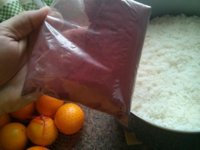Before anyone asks, not sake. All sake is rice wine but not all rice wine is sake. This would be the equivalent of farmhouse rice wine that nearly every Asian country has an example of. This is an easy wine that uses 4 things:
Rice (I've experimented and the only types that don't work are the common long grain rice and the uncle Ben's style of parboiled rice. The shorter the grain, the higher the polish the better the wine)
Water
Yeast balls (a. oryzae+yeast+god knows what)
Red yeast rice (optional, m. purpureus is basically the parent of lovastatin so if on statins omit)

Step 1: prepare rice. For this big a batch I find it easier to do away with more traditional ways of making rice and instead boil the water then add the rice stirring constantly until the water begins to come back to a boil, then drop the temperature to low returning the lid to the pot. After 20 or so minutes turn the pot off and allow rice to come to room temp over night.



The next day add your mix of rice balls and ryr. I powder this mix at 3 rice balls and 1 cup ryr, then sprinkle one heaping tablespoon all over the top of the rice.


Upend your cook pot over the Homer bucket so it slides out in one big chunk of rice, with the powder you added on the bottom now.
Add another heaping tablespoon of powder to the top of the rice in the Homer bucket.

Stab the top once the powder has been distributed over the surface, this drives the mould spores into the middle of the mass of rice.
Date your bucket, seal the lid, take a thumb tack and poke 5 or so holes in the center of the lid. Put somewhere 70 degrees for a month. Don't check it, don't stir it don't even think about it.
After a month it's done

Take the bucket out and pour into another bucket with a 5 gal paint strainer bag in place.

Pick the bag up to separate the wine from the unconverted rice, squeezing where necessary.
Bottle up.

This rice wine is ready to drink immediately, if left for too long you'd want to pasteurize it to avoid a lacto ferment from souring it, some people like to let it sour, I drink it before that.
The water to rice ratio controls the sweetness, I like 1 gallon water to 5 lbs rice, it's a nice in between I find.
Rice (I've experimented and the only types that don't work are the common long grain rice and the uncle Ben's style of parboiled rice. The shorter the grain, the higher the polish the better the wine)
Water
Yeast balls (a. oryzae+yeast+god knows what)
Red yeast rice (optional, m. purpureus is basically the parent of lovastatin so if on statins omit)

Step 1: prepare rice. For this big a batch I find it easier to do away with more traditional ways of making rice and instead boil the water then add the rice stirring constantly until the water begins to come back to a boil, then drop the temperature to low returning the lid to the pot. After 20 or so minutes turn the pot off and allow rice to come to room temp over night.



The next day add your mix of rice balls and ryr. I powder this mix at 3 rice balls and 1 cup ryr, then sprinkle one heaping tablespoon all over the top of the rice.


Upend your cook pot over the Homer bucket so it slides out in one big chunk of rice, with the powder you added on the bottom now.
Add another heaping tablespoon of powder to the top of the rice in the Homer bucket.

Stab the top once the powder has been distributed over the surface, this drives the mould spores into the middle of the mass of rice.
Date your bucket, seal the lid, take a thumb tack and poke 5 or so holes in the center of the lid. Put somewhere 70 degrees for a month. Don't check it, don't stir it don't even think about it.
After a month it's done

Take the bucket out and pour into another bucket with a 5 gal paint strainer bag in place.

Pick the bag up to separate the wine from the unconverted rice, squeezing where necessary.
Bottle up.

This rice wine is ready to drink immediately, if left for too long you'd want to pasteurize it to avoid a lacto ferment from souring it, some people like to let it sour, I drink it before that.
The water to rice ratio controls the sweetness, I like 1 gallon water to 5 lbs rice, it's a nice in between I find.
Last edited:

